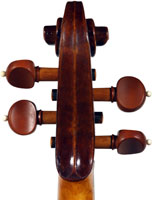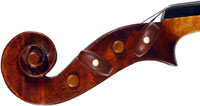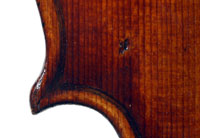|
Ref : 1050
A good violin of Unknown Origin |

go to Home Page see more Violins |
Despite its replicated Amati label, it can be stated with confidence that this violin has nothing to do with Nicola Amati. It is however loosely based on the typical Amati pattern, notably in the shape of the corners and the Fs, but that is where any resemblance to Amati ends. Wear in the violin suggests its production being in the mid to late 19th century, but certainly not much older.A disparity in workmanship between the scroll - which is hardly more than perfunctory - and the rest of the violin, could lead one to surmise that the scroll is not original to the violin. This idea could be supported by the fact that it has a neck graft, but certainly doesn't date from the 18th century which would have justified a systematic neck graft. Thus the only conclusion is that the original scroll may have been replaced for any number of reasons. But that remains conjecture.
This is a very nice-looking instrument in very good condition - in its entirely it is completely free from cracks. The two-piece back is of mildly-flamed maple. The ribs are made up of six unmatched bands of maple, varying from nicely-flamed to completely plain. The top is of good tone spruce with quite a wide grain, reminiscent of a French predilection for open-grained wood in the tops. In fact, this choice of material for the top, along with classical French arching, a back length of 360 mm and a considerably reddish tinge to the varnish, could lead one to speculate that this violin could be of French origin. But again, that remains speculative.
The best part of this violin is its tone - it is particularly well-toned and robust with good projection and balance. It's a pleasure to play on.
 |
 |
 |
||
 |
Dimensions : Length of back: 36.0 cm
Condition : Excellent condition, completely free from cracks and repairs. It appears that the varnish may have been retouched.
Provenance : Withheld
Price : On request
 |
 |
 |
 |
 |
 |
 |
 |
 |
 |
 |
 |
|||||
 |
 |
 |